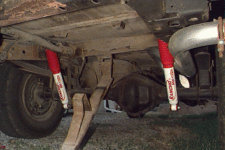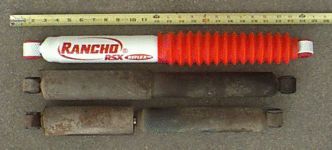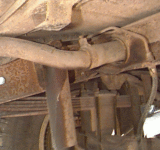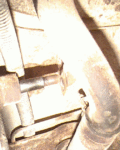 When I bought the Wag, it stood taller than most Wagoneers, as though it had a 2″ (give or take) suspension lift. The springs appear to be the factory heavy-duty suspension option. The rear has 2-3″ lift blocks, so I’m guessing the fronts may have been re-arched at some point to match, then sagged some. It also had some ancient Monroe shocks of approximately stock length which felt pretty squishy. Disconnecting the lower mounts indicated that the front shocks allowed only 1″ of droop beyond the normal rest position (18.5″ eye-to-eye). The rear shocks were slightly better off, allowing about 2.5″ of droop. This meant that every time a wheel tried to drop into a hole or off of a speed bump, the shock would bottom out and the vehicle body would be jerked downward, making for a rough ride and bringing about a premature demise for the shocks.
When I bought the Wag, it stood taller than most Wagoneers, as though it had a 2″ (give or take) suspension lift. The springs appear to be the factory heavy-duty suspension option. The rear has 2-3″ lift blocks, so I’m guessing the fronts may have been re-arched at some point to match, then sagged some. It also had some ancient Monroe shocks of approximately stock length which felt pretty squishy. Disconnecting the lower mounts indicated that the front shocks allowed only 1″ of droop beyond the normal rest position (18.5″ eye-to-eye). The rear shocks were slightly better off, allowing about 2.5″ of droop. This meant that every time a wheel tried to drop into a hole or off of a speed bump, the shock would bottom out and the vehicle body would be jerked downward, making for a rough ride and bringing about a premature demise for the shocks.
I’d originally had my eye on the Edelbrock IAS shocks for the Wag. They’re reputed to be the best on-road shock available, but that quality comes with a $75/shock price tag. The Rancho RSX shocks use a similar technology with similar results. When I saw that Rancho was running their “buy 3, get 1 free” deal, I decided to spend $150 on RSX’s instead of $300 on IAS’s.
Disconnecting the shocks and maximizing the axle articulation as best I could indicated that I could really use 21″ long shocks up front and 23″ long shocks in the rear. I solicited the help of Jamison at Advance Auto and his Rancho parts catalog. It turns out Rancho doesn’t make an RSX for lifted FSJ’s — at least not intentionally. By comparing the eye style and my required lengths with the list of all RSX shocks, we found that several Ford F150/Bronco shocks would work well for my lifted FSJ. These shocks have an EB1 upper eye (“E” for eye, “B” for bushing w/o a metal sleeve) on top and an ES65 eye (“S” for metal sleeve, “65” for 12mm I.D.) on the bottom.
| Rancho Part # | Compressed Length | Extended Length | Application |
|---|---|---|---|
| 12.000″ | 19.25″ | approximate original front | |
| 12.500″ | 20.50″ | approximate original rear | |
| 15.000″ | 21.00″ | my minimum new length, front | |
| 15.000″ | 23.00″ | my minimum new length, rear | |
| RSX17007 | 13.000″ | 20.75″ | stock ’76-91 Wag/Chero/GW, ’63-73 4×4 Gladiator, ’82-86 CJ-7/8 |
| RSX17016 | 13.500″ | 21.75″ | ’80-96 4×4 Bronco, ’80-84 4×2 F-150 |
| RSX17301 | 14.875″ | 24.50″ | ’94-96 4×4 Bronco |
| RSX17009 | 14.875″ | 24.75″ | ’80-96 4×4 F-150, ’80-91 4×4 F-250 |
The 17016’s were perfect for up front. I debated going with 17301’s in back to allow for full droop, but ended up getting 17016’s all around. Since the Wag will be used for towing and never for serious wheeling, I figured the extra compression was more important than the extra droop. I wish they had something closer to 14.0-23.0″ for a rear shock so I could maximize hard-bump tolerance and not waste 1.5″ of unneeded extension. Lowering my bump stops will probably be a priority when I start towing a lot.
4-Wheel Parts Wholesalers, where I bought the RS9000’s on my YJ, had free shipping on shocks at the time, so that’s where I ordered my RSX’s from. When I placed my order, they claimed to have the shocks in stock, but when they didn’t show up a week later, I called & found that they’d been back ordered and actually got shipped four days later than expected. I wasn’t in a hurry, so this was no big deal.
Removing the old shocks was simple except for some stubborn nuts (with insufficient clearance for my impact wrench) and the left rear upper mount. That shock eye was sandwiched on the pin behind a mounting tab for the gas filler tube. In order to remove the tab far enough to get the shock eye off & on, I had to disconnect the filler tube at the rear end under the body (see here) and pull it to the right. Even then it was a tight fit.
- Problem mount
- Problem mount
The only problem installing them was that Rancho insists on using 12mm ID sleeves, which are .5mm smaller than the stock 1/2″ bolts. 7/16″ bolts will work, but they’re quite loose and will rattle around. Fine thread M12 x 60mm metric bolts are $4 each around here, so I opted for the coarse thread versions at $2 each.
The old shocks offered very little resistance to compression, which explains the soft, yacht-like ride and terrible cornering. The new RSX’s offer much better handling, especially around corners. They’re also much better over speed bumps thanks to their correct length. I do feel rough roads more than I’d like, but it’s not too annoying, and well worth the improved handling I now have.
Do you like this site?
Help me keep it going by throwing a few pennies my direction.
![]()
![]()
![]()
![]()
Links on this page to Amazon are part of an affiliate program that helps keep Jedi.com operational.
Thank you for your support!



